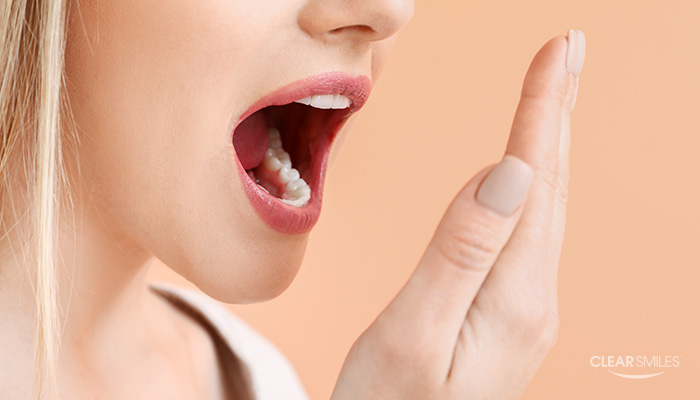Bad breath. Blech. No one likes to smell it and no one likes to talk about it. But halitosis affects about 25 percent of the population, or one in four people. Chances are, you’ve told someone you’re close to that their breath stinks. Or maybe, to your own embarrassment, someone has said you have bad breath. After you reach for the mints, it’s time to educate yourself on bad breath, how you get it, and how you can get rid of it.
The scientific name for bad breath is halitosis, and if you have a bad case of it that gum, mouthwash or a good brushing won’t solve, you suffer from chronic halitosis. Unlike simple morning breath, which everyone has, halitosis stays with you for a long period of time no matter what temporary measures you take.
Halitosis often causes a lot of worry, embarrassment, and anxiety, but there are steps you can take to lessen or eliminate it. It starts with good dental hygiene, part of which is taking good care of your teeth with clear aligners.
But first, let’s take a look at how you get bad breath in the first place.
Sources of Bad Breath
There are many causes of bad breath, and most involve the foods you eat. Other sources stem from poor oral hygiene. Halitosis usually originates in the mouth, where bacteria proliferate. When eating, small particles of food get caught in your teeth, and then bacteria grow on them and release foul-smelling sulfur compounds.
While certain foods like garlic and onions are the main culprits, another big source of bad breath is poor dental hygiene. When you don’t brush and floss often enough, the bacteria in your mouth continues to grow, forming a thin film of plaque build-up. If you don’t brush away plaque twice a day, it gives off a foul odor and leads to tooth decay.
All foods will become stuck in your teeth, but certain types of foods such as onions and garlic most commonly lead to bad breath. When you digest these foods, they release sulfur compounds into your bloodstream. When that blood reaches the lungs, it impacts your breath.
While 90 percent of bad breath instances will originate in the mouth, sometimes it’s due to acid reflux, infections, renal failure and complications from diabetes.
But back to food. Here are the main culprits:
- Garlic, onions and spicy foods
- Coffee
- Tuna and other types of fish
- Alcohol
- Carbonated beverages
Bad Breath Cures
Now that we know what causes bad breath, let’s talk about how you can get rid of it! After all, no one wants to be around someone with foul breath. It’s time to take control of your breath and make sure you smell fresh all day long, no matter what you’ve eaten.
- Crunchy Fruits and Vegetables: Reach for firm, crispy fruits and veggies, such as apples, celery, carrots and broccoli. They increase the flow of saliva, which washes odor-causing debris away. Bonus: the fibrous texture of fruits and vegetables will help to clean your teeth.
- Fresh Herbs: Chew on fresh herbs, such as parsley, basil, mint, tarragon, rosemary or cardamom.
- Vitamin C fruits: Eat melons, citrus fruits, and berries. These all contain lots of vitamin C, which helps to fight bacteria in your mouth and boost oral health.
- Yogurt: This contains healthy bacteria that help combat bad bacteria in many parts of your body, such as your gut.
- Zinc: This decreases the number of sulfurous compounds in your breath.
- Sugarless Gum: This will stimulate saliva to rinse away bacteria and keep your teeth clean. Plus, because it’s sugarless, you can chew as much as you want without getting cavities.
- Cinnamon Sticks: Cinnamon contains essential oils that kill the bacteria in your mouth, the cause of bad breath.
- Green tea: This has disinfectant and deodorizing properties that can freshen breath. Mint has a similar effect, so try a cup of green mint tea for the best results.
- Apples: This fruit will neutralize the compounds in the bloodstream, rather than simply deodorize the mouth.
- Good dental hygiene: It’s important to prevent plaque buildup to maintain a healthy mouth and prevent bad breath. Brush your teeth using a fluoride toothpaste twice a day for two minutes each time. Floss at least once per day. Scrape your tongue as well, which is where a lot of bacteria can accumulate. Finish up with mouthwash. You can even make your own with baking soda.
Did you know Invisalign can help combat bad breath? That’s because straight, well-aligned teeth are easier to keep clean because they don’t harbor food particles like crooked teeth can.
Kiss your bad breath goodbye with better dietary choices and better oral hygiene practices. Start off with a free virtual consultation on our clear aligners when you call us today.


